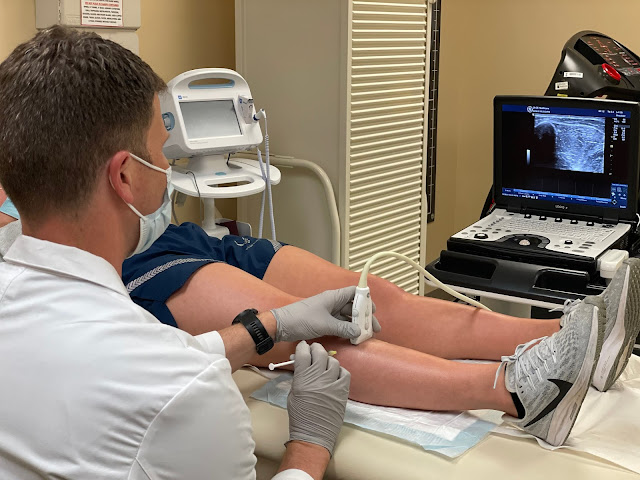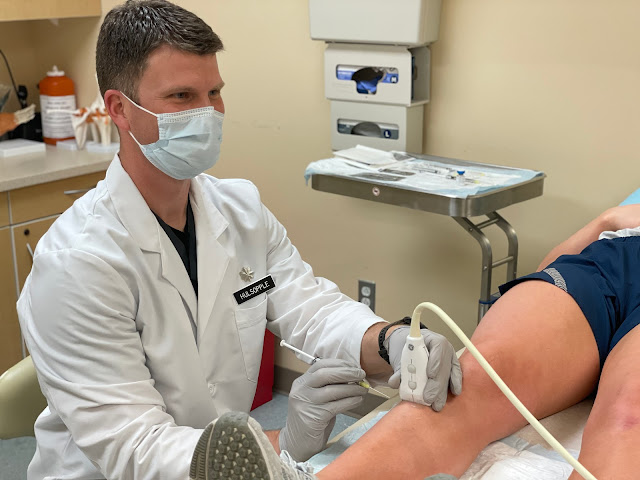USU Sports Medicine Researchers Find Surprising Application for Botox
By Dillon Parker
A popular cosmetic treatment, botulinum toxin (BoNT-A), best known by the brand name Botox, may also be used to treat several different types of musculoskeletal disorders, according to a review published by researchers from the Uniformed Services University of the Health Sciences’ (USU) Primary Care Sports Medicine fellowship. The researchers reviewed existing analysis and evidence from their practice that suggests BoNT-A injections can provide pain relief and functional improvement in some common conditions such as chronic exertional compartment syndrome (CECS), plantar fasciopathy, tennis elbow, and osteoarthritis.
The review “Utilization of Botulinum Toxin for Musculoskeletal Disorders” was published online in the journal Current Sports Medicine Reports, and credits USU’s Army Lt. Col (Dr.) Chad Hulsopple, the Primary Care Sports Medicine fellowship program director, and Army Maj. (Dr.) Clint Moore, Primary Care Sports Medicine faculty at Womack Army Medical Center, and the primary author of the study.
Each of these disorders cause pain in different ways and in different parts of the body. CECS causes pain predominantly in the lower extremity. Plantar fasciopathy is characterized by inflammation and pain in the heel. Osteoarthritis affects the knees, shoulders, and other joints. Tennis elbow affects the elbow, and sometimes the pain extends to the forearm and wrist.
While there are several existing treatments for these conditions, there is a need for more effective treatments. The definitive treatment for CECS, surgical fasciotomy, has about a 55% success rate, with 20% of service members being referred for medical discharge. Osteoarthritis remains the most common reason for medical discharge in the military, despite the existence of several types of treatments. Several treatments also exist for plantar fasciopathy and tennis elbow, however, a number of cases resist treatment.
Moore began evaluating emerging therapies for these disorders while a sports medicine fellow at USU due to their occasional treatment-resistant nature.
“I started looking into botulinum toxin in fellowship because we were focusing on effective therapies for the cases that failed standard treatments,” says Moore. “There are a lot of promising studies that show botulinum toxin produces results and can save patients from pain, functional limitations, or corrective surgery.”
Due to the strength of the preliminary research and limited side effects of the treatment, Moore and his colleagues started using BoNT-A injections to treat these disorders in their own practice.
“The side effects, which are short-lived muscle weakness, and the effectiveness of the therapy made it a good option when we discussed risk vs. benefit,” says Moore. “The results we’ve seen in practice closely match the research findings that BoNT-A is an effective therapy for these disorders.”
 |
| BoNT-A injections are an emerging treatment for several musculoskeletal disorders such as osteoarthritis, which is the most common reason for medical discharge from the military. (Courtesy photo) |
Although the research is promising, Moore and his colleagues point out this use of BoNT-A is off-label. Off-label use of medications is a common practice in medicine. This practice is when a medication is used in a manner not specified in the Food and Drug Administration’s approved package insert. This does not reflect the safety or efficacy of the medication for the off-label use.
"The use of botulinum toxin for these conditions is uncommon in civilian practice because of the variability of insurance coverage and the out-of-pocket expense for these treatments," explains Hulsopple. "In refractory cases, it is more commonly available in the military to bridge treatment gaps. There is limited high-quality evidence that demonstrates the frequency and dose of botulinum toxin injections for these conditions. Repeat injection therapies may be required. Long-term studies are necessary to establish the efficacy of botulinum toxin and the long-term outcomes."






